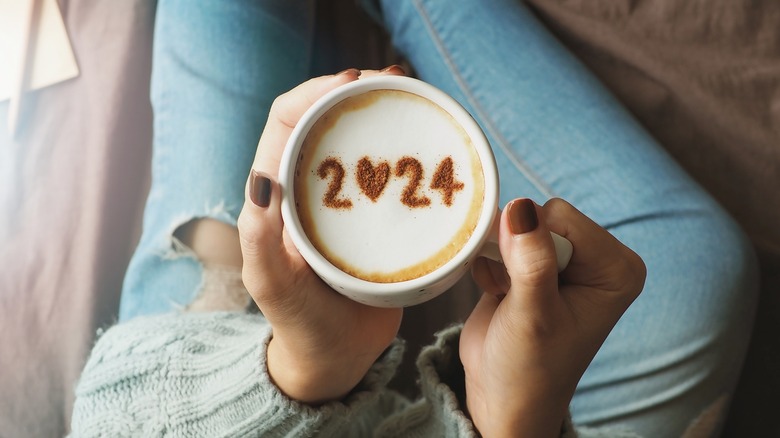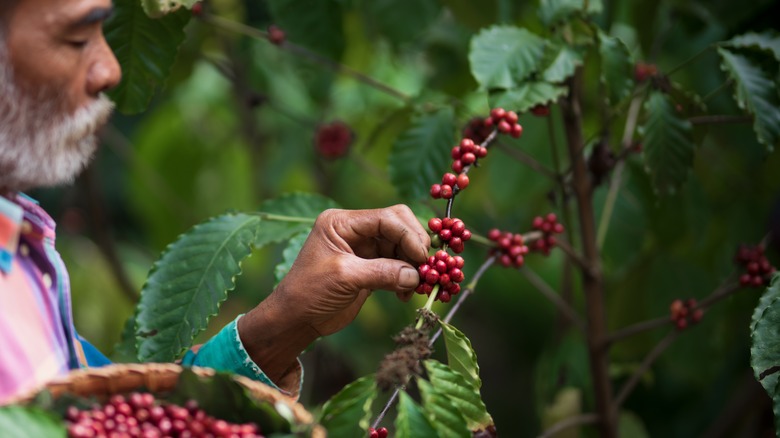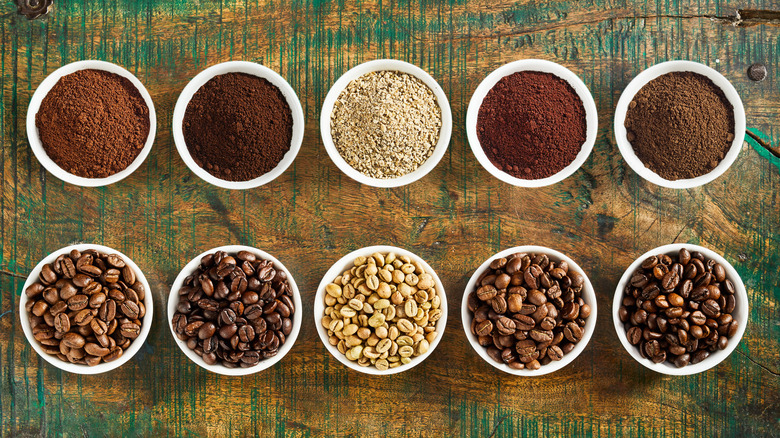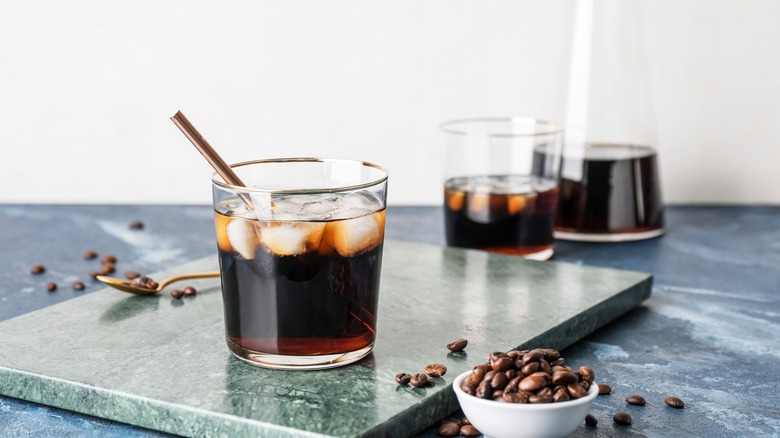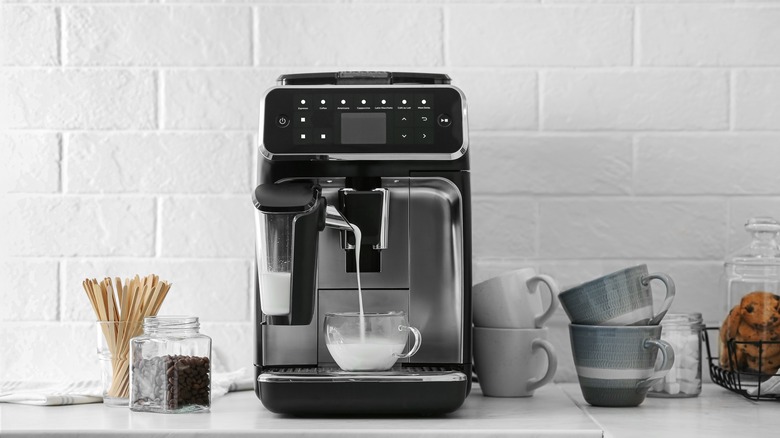The Exciting Top Coffee Trends For 2024
A latte a day keeps the doctor away, right? If only! Still, coffee remains the star of so many regular rituals, whether that's a steaming hot morning espresso made from home in a barista-approved machine, or an afternoon cold brew pick-me-up from your favorite café. Coffee is also endlessly customizable to your preferences or mood, and you have the ability to make conscientious choices when it comes to how you source it as well. If these scenarios sound similar to your java routines, you are right on trend for what's in store in the upcoming year.
Sustainably sourced products, single origin beans, cold brew coffee, and elaborate at-home coffee making setups are among the trends brewing up in 2024. Pinterest is also predicting that the "cafe core" vibe will be trending, after seeing significant spikes in searches for terms like "coffee bar styling" and "coffee station décor." In fact, in the United States, coffee is consumed more regularly on a daily basis than water, as the National Coffee Association found, meaning there's lots of room for caffeine trends to grow. Here's a deeper look at what's likely coming in 2024.
Starting at the source of coffee
When it comes to coffee, the place it was grown and how it was harvested really matters, and that only will become more important in 2024. Sustainably-sourced coffee considers the environmental impact of growing the beans, the conditions of workers at all stages of production, and the long-term viability of coffee farms.
Coffee is typically grown in tropical forests on sloped terrain, but the demand for cheaper options has been putting pressure on farmers to expand their growing area — which can lead to deforestation and erosion. Trying to sell a product at an unreasonably low cost also makes it more likely that workers will be underpaid.
Consumers can prioritize sustainability by being willing to pay a fair price for coffee beans, which, in turn, bolsters the whole supply chain. If this sounds like the kind of intentionality you want to bring into 2024, look for products with reputable certifications from organizations such as Fairtrade International and the Rainforest Alliance.
Fairtrade International pays coffee producers a guaranteed minimum to help insulate them from fluctuations in the market, allots funds for community and business development, and facilitates cooperative building so coffee farmers have greater collective bargaining power. The Rainforest Alliance supports coffee farmers in developing growing practices that combat climate change, improving farm management, and creating their own metrics for success. Farmers with this certification must be actively improving the biodiversity of the area, not just limiting the negative impacts of cultivation.
A bigger emphasis on single origin beans
The coffee industry is huge, and by the time you are sipping away on a hot cup of joe, you may not know where those beans actually came from. Coffee production has many steps, and typically, beans from numerous farms are sold several times to different processors as they are hulled, fermented, dried, cleaned, stored, graded, roasted, and distributed.
While that doesn't necessarily mean that mass produced coffee tastes bad, you do lose the story of the bean in the process. It's like the difference between a commercially produced wine that is engineered to taste the same from year to year and a wine from a vineyard where the makers can speak to the unique factors that contributed to the taste of each vintage. Being able to pinpoint the source of the coffee beans is called traceability, and that means that beans with a single origin can be traced back to a specific farm, cooperative, or region.
Seeking out single origin beans allows you to more clearly see how the taste of the final brew is influenced by specific bean varietals, processing techniques, climates, and the ethos of individual farmers. Maybe you will find that you love the sweet and floral pacamara varietal that El Salvador is known for, or perhaps you start to crave dark roast Tanzanian peaberry coffee with notes of stone fruit and caramel. You truly can take your tastebuds on a tour around the world with single origin coffee beans.
Cold brew is sticking around
Cold coffee drinkers have fallen in love with the silky smooth texture and low acidity of cold brew coffee, and the love affair will seemingly continue in 2024. The data is significant — the popularity of cold brew has increased by 45% since January 2023 and around 300% since 2016, reports the National Coffee Association.
Rather than a standard iced coffee where hot brewed coffee is chilled over ice, cold brew is literally made in cold water. The pleasant flavors are coaxed out over a long period of time, and a lot of the compounds that produce bitterness do not make it into the final brew. For those after a morning jolt or afternoon recharge, cold brew also tends to have more caffeine than espresso and other cold coffee types. However, the amount can vary significantly based on the type of coffee bean, how much is used, the size of the grind, and steep time.
Cold brew coffee is also commonly made in a concentrated form that can be diluted with water, ice, or your milk of choice. Regardless, the flavor profile remains generally mellow and, since it doesn't have a harsh acidity, it's delicious served as is.
Bringing the coffeeshop to you
You can absolutely get a taste of the coffee trends for 2024 at your favorite local coffee shop, but you can also bring the experience home. Coffee lovers are investing in aesthetically pleasing coffee brewing stations, high-quality espresso machines, and programmable tech-forward tools with features like voice activation and smartphone syncing.
This shift really took hold during the peak of the Covid-19 pandemic due to shutdowns and the transition to working remotely, but it appears to be sticking around. Despite the fact that folks can now more freely enjoy their coffee in public or back in the office, social media is full of fun recipes for flavoring syrups, homemade coffee concoctions, and dupes of popular beverages from chains.
People are putting their at-home barista skills and professional machines to the test, and even trying to learn how to create latte art at home. It is all about creating a personalized and memorable experience, and it appeals to anyone trying to save a buck, too.

